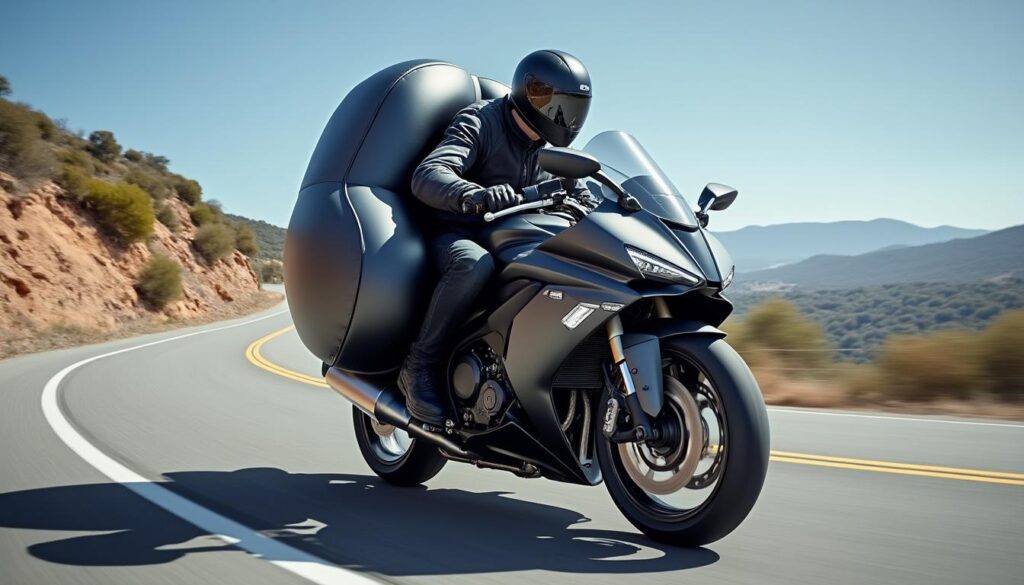The airbag for motorcyclists makes a significant leap forward

The safety of motorcyclists is an increasingly concerning issue worldwide. With an alarming number of accidents and injuries each year, technological innovation has become imperative. Motorcycle airbag systems, once considered a luxury, are rapidly transforming into a necessity. By 2025, equipment such as airbag systems for motorcyclists, developed by pioneering companies like Toyoda Gosei, marks a significant advancement. In a field where every second counts, these technologies can potentially change the game in terms of protecting motorcyclists. By examining the evolution of motorcycle airbags, we discover how their integration could transform the motorcyclist's experience and enhance their safety on the road.
The Importance of Airbags for Motorcyclist Safety
The rise of motorcycle airbags primarily addresses the inherent vulnerability associated with riding on two wheels. Compared to drivers, motorcyclists are more exposed to road dangers. Collisions can result in serious, even fatal, injuries. Airbags, which have established themselves as essential safety equipment in cars for several decades, are starting to appear in the motorcycle world. This raises the question: why have motorcycle airbags not been adopted sooner?
The answer partly lies in the complexity of motorcycle accidents. Unlike cars, two-wheeled vehicles present more variable collision dynamics. The interaction between the rider and the vehicle makes defining effective airbag systems more difficult. However, these challenges have not deterred companies such as Toyoda Gosei from developing innovative solutions. In 2025, the technology is finally ready to make a significant leap forward.
Some recent data indicates that 6,335 motorcyclists lost their lives on roads in the United States in 2023, highlighting the urgency to improve motorcyclist safety. Additionally, the airbag vest models developed by brands like Klim, Dainese, and Rev'it! show a growing interest in affordable and accessible alternatives for everyone. Comparatively, these technologies could significantly reduce the injury rate in accidents, preventing severe damage to the chest, ribs, and head.

Different Motorcycle Airbag Technologies
Within this innovation, two main types of airbags can be identified: those built into the motorcycle and those worn by riders in the form of vests or jackets. Each of these solutions has its advantages and disadvantages.
- Integrated airbags: These airbags are installed directly within the motorcycle's structure. In the event of a collision, they deploy to protect the rider. This is a promising approach, although its integration into all models remains complex.
- Airbag vests: These portable devices inflate rapidly in the event of a fall or collision. They have the advantage of being easily accessible and can be used with different types of motorcycles. Brands like Bering and Spidi have developed stylish and functional models that appeal to motorcyclists.
To make this technology more accessible, manufacturers have also lowered production costs, allowing for a gradual democratization. Entry-level models are now available without compromising user safety.
Concrete Examples and Market Data
Market studies reveal that by 2025, over 30% of new motorcycle models could be equipped with integrated airbag systems, following initiatives by companies like Toyoda Gosei. Their latest test on a prototype demonstrated that the airbag can effectively absorb the impact of a collision, providing significant protection to the motorcyclist. Additionally, brands like IXS and Held are also committed to integrating this technology into their new vest models using lightweight technical fabrics for better maneuverability.
| Brand | Type of airbag | Targeted protection | Approximate price |
|---|---|---|---|
| Toyoda Gosei | Integrated | Chest, neck | Unavailable |
| Klim | Vest | Chest cage, shoulders | €450 |
| Dainese | Vest | Back, ribs | €500 |
| Rev'it! | Vest | Chest cage, midsection | €480 |
The potential of this equipment to reduce the risk of severe injuries is immense. A recent study shows that in the case of effective deployment, airbags can reduce the injury risk by 30 to 40% in moderate-speed accidents. Vacationers and recreational motorcycle users are beginning to realize the importance of investing in their personal safety by integrating airbag devices into their gear.
Evolution and Development of Motorcycle Airbags
The design and development of motorcycle airbags have undergone notable evolution. Many companies are now focusing on systems capable of adapting to the diverse dynamics encountered by motorcyclists during accidents. An essential phase of research involves developing prototypes capable of detecting the different types of collisions, primarily utilized during accidents in urban environments.
Indeed, frontal and lateral collisions differ in terms of forces involved. The company Toyoda Gosei has recently begun extensive testing involving mannequins and real vehicles. These tests serve to verify not only the timing of the airbag deployment but also its interaction with the rider at the moment of impact. An often-overlooked evolution that could make a difference in the event of an accident.
The results of these tests will be crucial in establishing safety standards for future models of airbags integrated into motorcycles. With the integration of advanced sensors, these developments could potentially allow for better forecasting of impacts and, consequently, more precise deployment of airbags. The project for expanding this technology is ambitious but demonstrates manufacturers' commitment to improving motorcyclist safety.

Collaboration Between Industry and Researchers
The collaboration between industry and academia is a major strategic axis for innovation in this field. Partnerships with academics allow for conducting sociological and technical studies on the impact of airbags on motorcyclist safety. Such an approach enables a better understanding of motorcyclist behaviors and the factors that determine the need for protective devices.
- Real-world testing is crucial for gathering reliable data.
- Computer modeling of accidents allows for anticipating better impact scenarios.
- The development of materials facilitates making airbags lighter and more effective.
Companies like Spidi and Macna partner with researchers to conduct tests and refine their safety devices. By integrating this applied research, companies are betting on greater compliance with safety regulations. This could allow them to bring innovative systems to market more quickly.
| Partner | Type of study | Potential benefit |
|---|---|---|
| University of Lyon | Sociological study | Understanding the behaviors of motorcyclists |
| Polytechnic School | Modeling | Anticipating impacts |
| CNRS | Advanced materials | Improvement of airbag performance |
These collaborations represent a promising momentum towards the continuous improvement of safety devices for motorcyclists. What if the development of the motorcycle airbag favored users and encouraged more motorcyclists to opt for this protection?
Regulations and Legislation Regarding Motorcycle Airbags
Legislation regarding safety equipment for motorcyclists is evolving, and this includes airbags. In the United States and several European countries, discussions are underway to establish minimum standards regarding protective equipment. The need for a clear legal framework is emphasized by tragic statistics on motorcycle accidents, which show that 30% of motorcyclists do not wear appropriate safety gear.
Recently, some countries have considered making the use of airbag vests mandatory, similar to what is already in place for other safety equipment. However, each initiative sparks debates. One major concern is the potential cost of these devices for consumers.
Companies such as Richa and Held advocate for the importance of a legal framework that would foster not only safety but also innovation. Incentive policies could facilitate the adoption of safety devices, encouraging their integration into all types of motorcycles, whether intended for road use or competition.
- The need for a clear and comprehensive legal framework.
- The acquisition costs for the motorcyclist must be reasonable.
- Public information on the benefits of airbags should be strengthened.
The ongoing discussions around regulation highlight an urgent need to elevate the safety level of motorcyclists. A solid legal framework could encourage manufacturers to invest more in the development of innovative and effective airbags.
| Country | Ongoing legislation | Status of adoption |
|---|---|---|
| France | Consultations for regulation | Ongoing |
| United States | Establishment of minimum standards | Discussion |
| Germany | Mandatory safety equipment | In force |
The regulatory landscape, while not general or uniform, remains promising. If these standards are implemented, it is highly likely that motorcyclist safety on the roads will experience a significant improvement.
Source: www.caradisiac.com
Leave a Reply



Articles relatifs